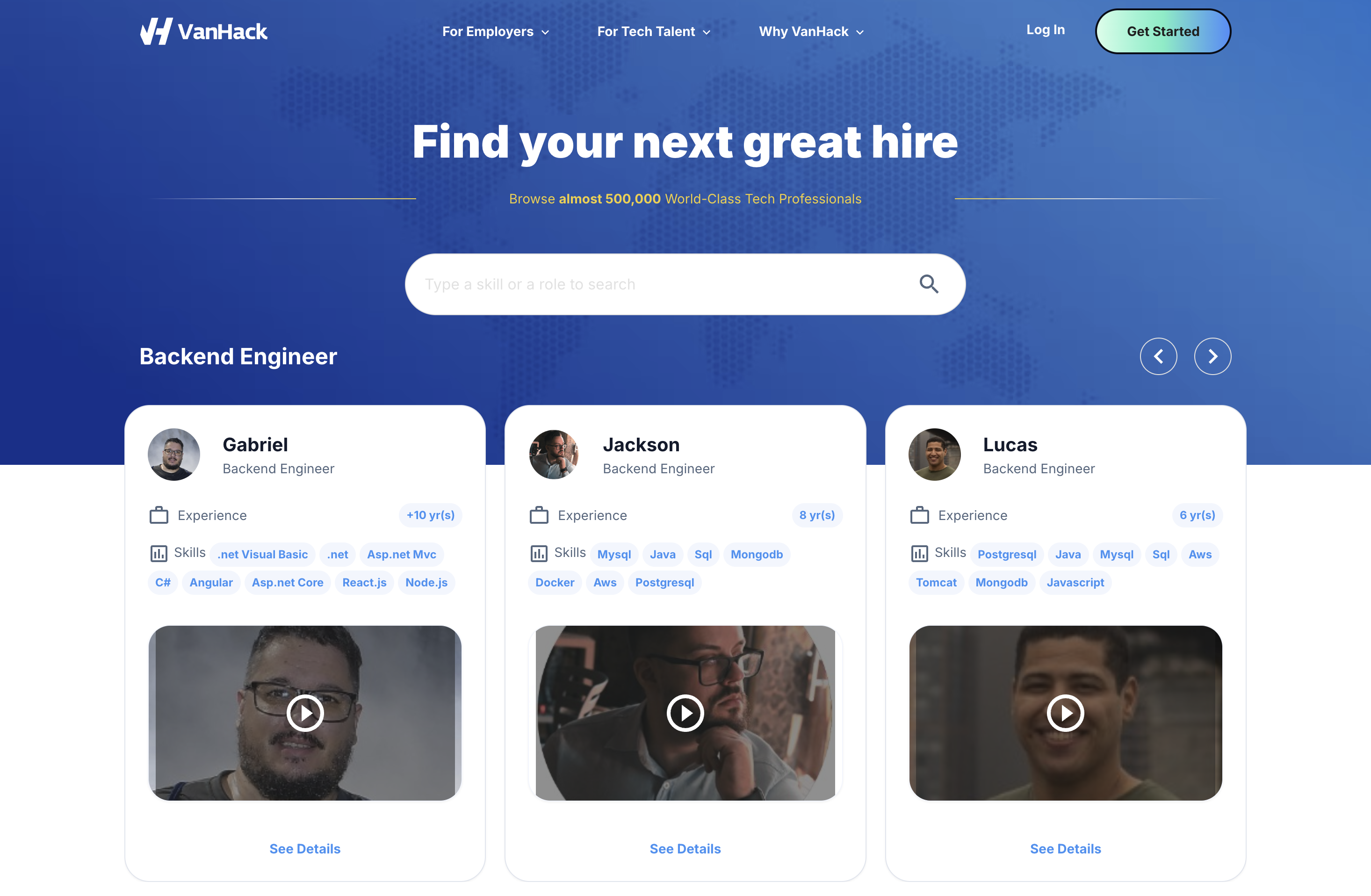US companies aiming to scale quickly face a growing challenge in finding skilled developers. Local talent pools and standard job boards often fall short for businesses needing cost-effective growth. This guide offers a clear plan for sourcing and onboarding remote senior developers from Latin America with help from specialized tech staffing agencies. It covers key terms, evaluation methods, and practical steps to boost your engineering team and speed up product development. Ready to build your team? Start hiring with VanHack to connect with pre-vetted LATAM talent now.
Why Remote LATAM Talent Matters for Your Growth
Sourcing remote developers from Latin America can be a game-changer for US companies, but it requires a solid plan to avoid common pitfalls. This section lays out the basics that engineering leaders and startup founders need to know to make smart choices about global hiring.
Understanding Key Terms for Hiring LATAM Talent
First, let’s clarify the difference between talent acquisition and recruiting when partnering with tech staffing agencies. Talent acquisition focuses on long-term goals, building connections with top candidates, and aligning hires with your company’s future needs. Recruiting, on the other hand, is about filling open roles quickly. For remote LATAM talent, a talent acquisition approach works better since it prioritizes cultural fit and lasting retention.
Next, defining engineering levels is crucial when assessing candidates. Senior engineers, with 5 to 7 years of experience, often have deep technical skills and can guide junior team members. Staff engineers, with over 7 years, think architecturally and influence multiple teams. Principal engineers, with a decade or more, set technical direction for the entire organization. Knowing these levels helps set fair pay and clear expectations for remote hires.
Finally, compensation in LATAM differs from the US. While US developers might value equity, LATAM candidates often prefer cash for financial stability. Tailoring offers to these preferences helps attract top talent without breaking your budget.
How to Assess Technical Skills and Cultural Fit
Evaluating remote developers goes beyond a single coding test. A strong approach combines asynchronous coding tasks, live problem-solving, and communication checks. For LATAM candidates, this means assessing English skills through video intros, technical clarity via AI interviews, and hands-on ability with standard tests.
Cultural fit is just as important in cross-border hiring. Look at how candidates collaborate, communicate, and adapt to US work styles. This includes familiarity with agile practices, remote work habits, and alignment with your company’s values. Good tech staffing agencies offer detailed cultural evaluations to predict long-term success.
For startups, hiring challenges are unique due to fast growth and tight resources. You need developers who work independently, adapt to shifting priorities, and deliver from day one. Thorough vetting and cultural checks become even more vital in these cases.
Aligning New Hires with Your Business Goals
Your talent strategy should tie directly to product goals and company growth. When hiring remote LATAM developers, pinpoint the exact skills needed for upcoming projects. Plan how they’ll fit into current workflows and ensure they can contribute to key initiatives. This requires careful onboarding and collaboration setups.
Timing also matters, especially for fundraising. Early-stage companies often need to show quick team growth to investors. Hiring skilled LATAM talent can help achieve this while keeping costs down. Plan hires to be productive before key funding deadlines.
Accessing global talent also boosts your market edge. It expands your team’s skills, enables round-the-clock work, and frees up budget for innovation. These benefits strengthen your company’s position over time.
Should You Build or Partner for Global Hiring?
Deciding whether to develop in-house hiring or partner with a tech staffing agency depends on your resources and goals. Building your own system means investing in recruiting tools, compliance knowledge, and LATAM market connections. This suits companies with ongoing hiring plans or existing global operations.
Partnering with an agency offers faster access to vetted candidates and added services like visa support. This works well if you need talent quickly or lack international hiring know-how. Your choice hinges on speed, budget, and internal capacity.
A clear framework can guide this decision. Assess your current recruiting setup, timeline needs, and budget. Many companies start with agency partnerships for quick hires while building internal skills for the future.
Why LATAM Talent Is a Must for US Companies Today
The global talent market has changed, opening new doors for US firms looking to grow their tech teams. Grasping these shifts helps you make better decisions about hiring strategies and partnerships.
Understanding the Global Talent Market
The tech talent space has distinct segments. Big tech firms snap up much of the senior US talent with high pay and benefits, leaving startups struggling to compete for similar skills at lower costs.
LATAM startup scenes have grown, especially in Mexico, Brazil, Colombia, and Argentina. These regions now produce developers skilled in modern tools, agile methods, and global business practices, often with strong educational backgrounds.
Cost savings are significant in LATAM. Senior developers there earn $30,000 to $50,000 yearly compared to $120,000 to $150,000 in the US. Overall hiring costs can be up to 70% lower in LATAM, allowing budget stretches for more hires or other priorities.
While consultancy models and platforms exist, they often miss the mark for startups. Consultancies lack long-term fit, and generic platforms don’t offer deep vetting or cultural checks needed for remote team success.
How Remote Work and AI Shape Hiring
Remote work has erased location barriers, letting US companies hire globally without relocation. This broadens your candidate pool and cuts hiring expenses.
AI tools have improved sourcing and vetting. Many agencies now use AI for candidate matching and skill assessments, offering better insights than resumes alone.
With US developer pay climbing, LATAM talent looks even more appealing. Companies can save 41% on compensation by hiring in Latin America without losing quality, redirecting funds to other growth areas.
Why Traditional Hiring Fails Startups
Job boards like LinkedIn pull in many applicants, but filtering for skills and fit takes too much time, especially across borders.
Referral networks lack the reach for rapid growth. Most startup teams don’t have strong LATAM connections, limiting this method.
General recruiters often miss the technical and cultural expertise needed for LATAM hires. They struggle to spot top candidates or gauge fit for remote startup roles.
Internal startup teams rarely have the capacity for global hiring. Managing international pay, cultural nuances, and logistics often exceeds their scope.
New Trends in Global Hiring
Engaging with tech communities in LATAM can attract better talent. Developers there are active online, contribute to open-source, and join virtual events. Companies showing genuine interest build trust and a strong brand.
Your employer brand matters beyond pay. LATAM developers value growth opportunities, cutting-edge work, and US company exposure. Highlighting these draws top candidates.
Post-hire community support adds value. Helping LATAM hires connect locally boosts retention and speeds up integration, a service many agencies now offer.
Key Factors in Hiring Remote LATAM Developers
Building a successful global talent strategy means weighing your resources, goals, and outcomes. These considerations help shape your approach and partnerships.
Internal Hiring vs. Agency Partnerships
Creating an in-house global hiring setup demands major investment in tools, market insight, and compliance. This fits companies with long-term hiring needs or global presence.
Agency partnerships provide instant access to talent networks and vetting processes, speeding up hires. The downside is ongoing costs and less direct control.
A hybrid model blends internal efforts with agency support. Many firms handle cultural fit internally while using agencies for sourcing and logistics.
Your decision should factor in hiring speed, budget, expertise, and strategic goals. Immediate needs often point to partnerships, while long-term plans may favor internal growth.
Costs and Resources for Global Hiring
Full-time international recruiters cost over $100,000 yearly, including pay and tools. They need specific LATAM market knowledge and technical vetting skills.
Agency fees depend on the model. Per-hire costs can hit 15 to 25% of salary, while subscription options like VanHack’s “Vanna” offer unlimited hires for $3,000 monthly, saving money for multiple roles.
Delays in hiring hurt more than direct costs. Unfilled engineering spots slow product progress and weaken your edge, making efficient hiring vital.
LATAM salary savings are clear. Senior engineers there earn $40,000 to $95,000 yearly, far below US rates of $120,000 to $150,000. Hourly rates range from $35 to $90 across LATAM countries, with higher rates in Mexico and Chile due to time zones and skills.
Integrating Remote Teams with Ease
Blending LATAM developers into US teams needs clear communication rules and inclusive dynamics to leverage diverse perspectives.
Set up communication plans considering language, time zones, and styles. Define key channels, meeting schedules, and documentation to keep collaboration smooth.
Train managers to lead remote LATAM staff effectively. Understanding cultural differences in feedback and relationships boosts retention and output.
Build team cohesion by fostering connections, offering mentorship, and ensuring equal input in decisions, strengthening your global culture.
Measuring Success with LATAM Hires
Track how quickly hires become productive. With good onboarding, LATAM developers often hit full stride in 60 to 90 days, based on role and support.
Retention can outpace US hires with fair pay, growth options, and inclusive settings. USD pay at competitive local rates builds loyalty.
Expect development speed to rise within 3 to 6 months after integration, with faster features and more innovation capacity.
Evaluate hire quality over 12 to 18 months, looking at technical impact and team fit. Ongoing growth opportunities ensure lasting value.
VanHack: Your Partner for LATAM Developer Talent
VanHack connects US companies with skilled LATAM developers, offering a focused solution for global hiring challenges faced by startups. Let’s explore how their platform can help.

What VanHack Offers for Global Hiring
VanHack supports startups in hiring senior tech talent for remote or relocation roles, targeting Series A to C companies with at least 20 staff. Many clients are North American firms hiring LATAM developers remotely.
They focus on senior engineers with 5 to 10 years of experience in full-stack, backend, and frontend roles, helping save time and reduce costs.
Their “Vanna” subscription, an AI-driven service, costs $3,000 monthly for unlimited hires, offering savings over traditional per-hire fees for multiple roles.
How VanHack Vets Candidates
Using AI, “Vanna” matches job needs with a database of over 500,000 tech pros, delivering a shortlist of 3 to 5 strong candidates quickly.
Video intros of 1 to 2 minutes let you assess communication and English skills early, cutting down on initial call time.
Coding tests via partners like Woven show technical scores on profiles, giving clear data before deeper interviews.
AI technical interviews, run by a tool called Ripples, provide 30-minute recorded sessions. You get videos, transcripts, and scores, offering a full view of skills and problem-solving.
Support for Relocation and Community
VanHack’s in-house team handles relocation, including visa work, housing, flights, and school setups, all within their pricing. This eases the burden for startups.
For relocated staff, local WhatsApp groups like “VanHackers in Toronto” build peer networks, aiding retention and cultural fit.
Their platform features a Kanban dashboard for reviewing candidates, detailed profiles with videos and test results, direct messaging, and easy interview scheduling, streamlining your process.
Discover top talent faster with VanHack and see these tools in action.
Comparing Tech Staffing Agencies for LATAM Talent
|
Feature |
VanHack |
Toptal |
Traditional Agencies |
|
Business Model |
Subscription or Success Fee |
Service Marketplace with Success Fee |
Per-hire Fee |
|
Talent Pool Quality |
Pre-vetted Senior Global Talent |
Pre-vetted Freelancers |
Varies, Often Generalist |
|
Vetting Depth |
AI, Video, Coding, AI Interviews |
Comprehensive (Technical, Language, Live Interviews, Test Projects) |
Basic, Limited Technical |
|
Global Mobility Support |
Full In-House Service |
None |
None |
This table shows VanHack’s strengths for US firms hiring LATAM talent, with focused vetting, support services, and cost-friendly pricing for growing teams.
Traditional methods often lack the depth and ongoing help needed for global hires. Generic platforms offer candidates but miss specialized cross-border expertise.
VanHack’s direct hire approach lets companies employ talent outright, fostering better alignment than ongoing contractor setups.
Are You Ready to Hire Remote LATAM Talent?
Global hiring success depends on your company’s readiness across several areas. Identifying gaps now helps build a plan for better outcomes.
Assessing Your Hiring Capabilities
Look at your recruiting processes, technical interviews, and cultural checks. Strong existing systems adapt easier to global hiring than informal setups.
Your technical vetting strength matters. Robust coding tests and architectural discussions help evaluate LATAM candidates confidently, unlike basic chat interviews.
Experience with remote or diverse teams aids cultural integration. Firms with global exposure often onboard LATAM talent more smoothly.
Ensure hiring ties to business goals and growth plans. Clear strategies for engineering hires maximize LATAM talent benefits.
Getting Stakeholders on Board
Key players like CTOs, HR leads, and founders shape global hiring. Understand their priorities and concerns for smooth alignment.
Implementation staff, including engineering managers and HR, need training to support remote LATAM hires effectively.
Strong executive backing helps tackle cultural challenges and ensures resources for global initiatives.
Coordinate with legal, finance, and operations early to handle compliance and payroll, avoiding delays.
Focusing on High-Impact Roles
Identify roles with the biggest business impact. Senior full-stack developers often deliver broad value, while niche roles like DevOps fill specific gaps.
Consider urgency from product deadlines or funding needs. Prioritize roles tied to immediate releases or strategy.
Cultural fit varies by role. Collaboration-heavy positions need extra focus on communication and alignment.
Complex knowledge transfer slows integration. Roles with clear docs and workflows onboard faster.
Deciding Between Internal or Agency Support
Check if your recruiting team can handle global sourcing and vetting. Most startups need external help for scale.
Spot expertise gaps like LATAM pay benchmarks or logistics. Agencies often fill these knowledge voids.
Weigh timeline needs. Urgent hiring favors agency speed over slow internal builds.
Compare costs of internal teams versus agency fees. Subscription models can save more for high-volume hiring.
Planning Hiring Around Business Growth
Time hires to support product goals, aligning onboarding with key deadlines.
Show team growth for fundraising. Scaling with LATAM talent can impress investors if timed right.
Address market timing. Hiring for competitive needs can give strategic edges.
Plan 60 to 90 days for full productivity of LATAM hires, factoring this into resource schedules.
Common Mistakes When Hiring LATAM Developers
Even experienced US teams face challenges in global hiring. Knowing these risks helps you avoid delays and setbacks.
Ignoring cultural nuances is a frequent error. Technical skills alone don’t ensure remote success. Different communication and feedback styles must be addressed to prevent turnover.
Misjudging pay complexity hurts talent attraction. Competitive local rates matter, not just savings. USD pay at top local levels builds loyalty. A pure cost-cutting focus misses quality hires.
Poor vetting wastes time. Standard interviews don’t fit global hiring. Tailored tools and methods are needed for remote assessments.
Overlooking compliance and payroll rules adds legal risks. Employment laws and taxes vary in LATAM, causing delays without planning or agency help.
Weak onboarding slows productivity. Remote LATAM hires need tailored support for technical and cultural integration, not just local-style processes.
Lack of communication plans hinders teamwork. Set protocols and schedules for time zones and styles to maintain efficiency.
Skipping career growth plans lowers retention. LATAM developers want advancement like US peers. Treating them as cost-savers risks losing talent.
Common Questions About Hiring LATAM Developers
What Are Salary Expectations for Senior LATAM Developers?
Senior LATAM developers earn much less than US counterparts while offering similar expertise. In 2025, annual pay ranges from $30,000 to $95,000 across key markets. Mexico sits at $55,000 to $95,000, Argentina at $40,000 to $68,000, Colombia at $50,000 to $80,000, and Brazil at $45,000 to $75,000. US seniors, by comparison, earn $120,000 to $150,000. Offering USD contracts at competitive local rates, paired with stability, attracts the best talent.
How Do US Companies Ensure Quality in LATAM Hires?
Quality comes from layered vetting beyond resumes. Use video intros for communication checks, coding tasks for skill proof, and AI interviews for problem-solving depth. Agencies like VanHack offer these tools. Assess cultural fit via structured interviews on collaboration and alignment with US practices. Verify past work through references and portfolios. Combining technical, cultural, and background checks lowers hiring risks.
Do Time Zones Pose Challenges with LATAM Teams?
Time zones are an advantage with LATAM. Countries like Mexico, Colombia, and Chile overlap significantly with US hours, aiding real-time teamwork. Mexico often matches US schedules closely. Set clear async work rules, core overlap hours, and strong documentation to keep workflows smooth. This setup often boosts productivity compared to other global regions.
How Does VanHack Support Relocation for LATAM Talent?
VanHack’s Global Mobility team manages relocation end-to-end. They handle visas for candidates and families, plus logistics like housing, flights, and schools, all within their fees. This frees companies from admin tasks. Hires can start remotely during visa waits, ensuring quick impact. Post-move, local “VanHacker” groups offer peer support for integration.
What Sets VanHack Apart for LATAM Hiring?
VanHack stands out with its “Vanna” AI subscription at $3,000 monthly for unlimited hires, saving costs over per-hire models. Their vetting includes AI matching, video intros, coding tests, and AI interviews for deep insights. Unlike contractor-focused platforms, they enable direct employment for better fit. Full relocation support and post-hire community groups enhance retention.
Boost Your Team with LATAM Developer Talent
The global tech market offers US companies a chance to grow engineering strength while managing costs. Hiring remote LATAM talent via specialized agencies like VanHack is a proven way to navigate tight US hiring scenes and build effective global teams.
Success depends on mastering vetting, cultural fit, readiness, and integration steps covered here. Companies that view global hiring as a core strategy, not just a cost tactic, see the best results.
VanHack simplifies this with AI matching, thorough vetting, and relocation support, tackling key hiring hurdles for startups.
LATAM talent brings cost savings, time zone alignment, and strong skills, creating real value for growing US firms. With the right processes, you gain a lasting competitive edge.
Ready to enhance your engineering team? Connect with top LATAM developers now through VanHack and start building today.



